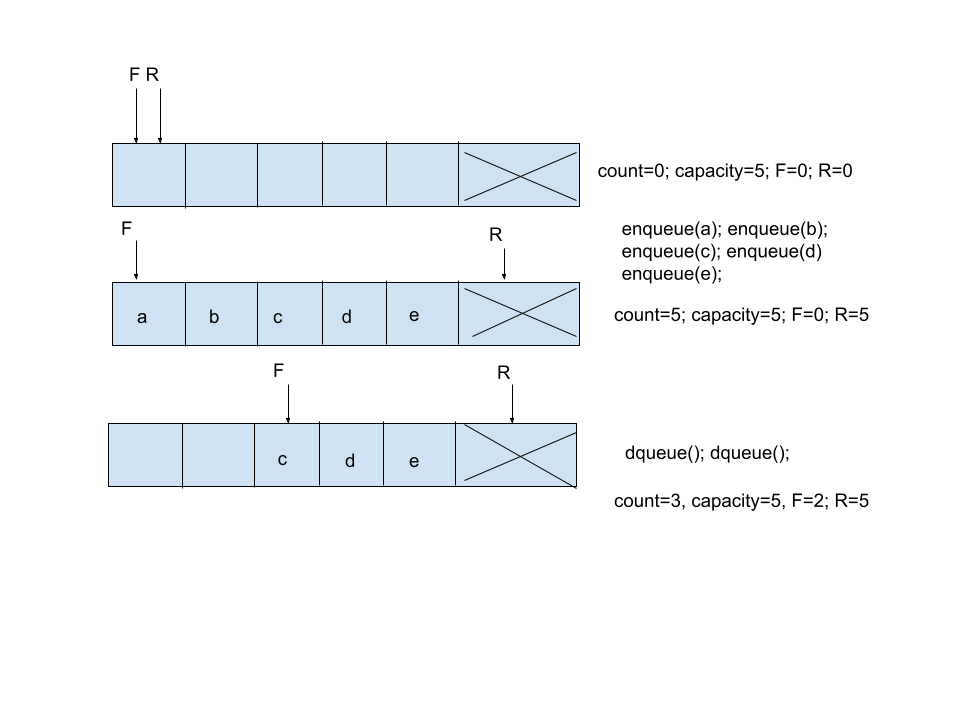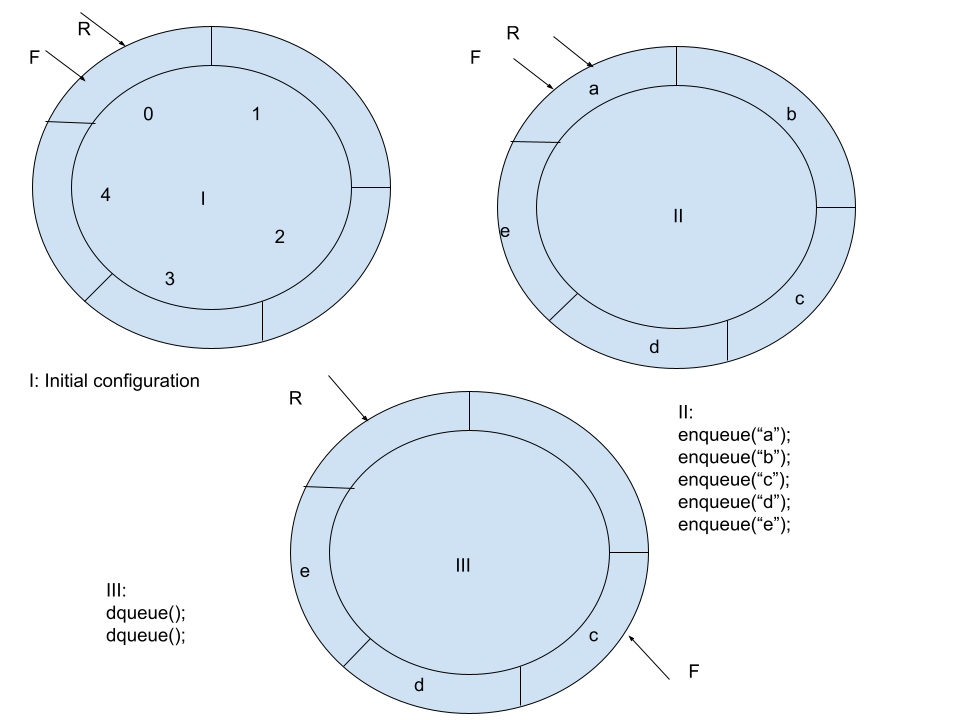Stacks and Queues
The Stack ADT
Stack is a last in first out datastructure. We can define the stack operations abstractly as an Interface as follows
public interface Stack<T> {
int size();
public boolean isEmpty();
public T peek() throws StackEmptyException;
public void push(T element);
public T pop() throws StackEmptyException;
public void print();
}
Now let us consider an application. We would like to reverse the
elements of an array. How to use a Stack to achieve this?
Let a be an array and let s be a Stack. Then, we can leverage the
LIFO nature of s as follows:
for (int i = 0; i < a.length; i++) {
s.push(a[i]);
}
for (int i = 0; i < a.length; i++) {
a[i] = s.pop();
}
 Get your hands dirty!
Get your hands dirty!
In the following you are given the first version of the Stack, which
is implemented using an ArrayList.
public class ArrayListStack<T> implements Stack<T> {
protected List<T> stackData;
protected int top = -1;
public ArrayListStack() {
this.stackData = new ArrayList<T>();
}
public int size() {
}
public boolean isEmpty() {
}
public T peek() throws StackEmptyException {
}
public void push(T element) {
}
public T pop() throws StackEmptyException {
}
public void print() {
StringBuilder sb = new StringBuilder();
sb.append("[");
for (int i = top; i > -1; --i) {
sb.append((stackData.get(i)).toString());
if (i > 0) {
sb.append(" : ");
}
}
sb.append("]");
System.out.println("Printing the stack contents with top being leftmost");
System.out.println(sb);
}
public static <T> void reverseArray(T[] a) throws StackEmptyException {
}
We will now do the following exercise in CodeRunner.
- The code snippet above is provided. You implement the
sizeandisEmptymethods. - Now implement the
pushmethod. - Next implement the
peekmethod. - Now implement the
popmethod. - Perform the following operations on a Stack and then print the stack
contents:
push(-10),push(-20), push(-30), pop(), pop(), push(0), push(100), pop(). What do you expect the output to be? - Implement the
reverseArraymethod. - In main create first an array of
Integerobjects, which is sorted in ascending order and now store the elements in descending order. - Likewise, create an array of
Stringobjects, which are in descending order. Store the elements in ascending order. - Print the contents of both arrays after the operations.
HOMEWORK
You need to develop a NodeStack that implements the Stack
interface. Using the same operations in the main method ensure that
you have identical behaviour for both stacks.
Consider the class Node we created before:
public class Node<T> {
private T val;
private Node<T> next;
// constructor
public Node() {
}
public Node(T v) {
val = v;
next = null;
}
// getters and setters
public void setNext(Node<T> n) {
next = n;
}
public Node<T> getNext() {
return next;
}
public T getValue() {
return val;
}
}
The Queue ADT
Queue is a first in first out (FIFO) data-structure with wide applicability.
public interface Queue<T> {
public int size();
public boolean isEmpty();
public T front() throws QueueEmptyException;
public void enqueue(T element) throws QueueFullException;
public T dqueue() throws QueueEmptyException;
public void print();
}

 Get your hands dirty!
Get your hands dirty!
In the following you are given the first version of the Queue, which
is implemented using an Array.
public class SimpleQueue<T> implements Queue<T> {
protected int front;
protected int rear;
protected int count;
protected int capacity;
protected T[] queueData;
public SimpleQueue(int capacity) {
this.front = 0;
this.rear = 0;
this.count = 0;
this.size = size;
this.queueData = (T[]) new Object[capacity];
}
@Override
public int size() {
// TODO Auto-generated method stub
return count;
}
@Override
public boolean isEmpty() {
// TODO Auto-generated method stub
}
@Override
public T front() throws QueueEmptyException {
// TODO Auto-generated method stub
}
@Override
public void enqueue(T element) throws QueueFullException {
// TODO Auto-generated method stub
}
@Override
public T dqueue() throws QueueEmptyException {
// TODO Auto-generated method stub
}
@Override
public void print() {
StringBuilder sb = new StringBuilder();
sb.append("[");
for (int i = front; i < rear; ++i) {
sb.append((queueData[i]).toString());
if (i < rear - 1) {
sb.append(" : ");
}
}
sb.append("]");
System.out.println("Printing the queue contents with front item being the left most");
System.out.println(sb);
}
We will now do the following exercise in coderunner
- The code snippet above is provided. You implement the
sizeandisEmptymethods. - Now implement the
frontmethod. - Next implement the
enqueuemethod. - Now implement the
dequeuemethod. - Perform the following operations on a Queue of
size=5and then print the Queue contents:enqueue("a"), enqueue("b"), enqueue("c"), enqueue("d"), enqueue("e"). What do you expect the output to be when you invokeprint? - Now perform two
dequeueoperations. - Now check the
size. - Finally try to
enqueue("f"). What happens?
Limitations of the SimpleQueue implementation
- While there is space available in the array i.e. the size of the
Queueis 3. Yet, we are unable to reclaim the available space toenqueue. - How can this be fixed? Can we wrap around
FandRwhen they reach capacity?
A CircularQueue
- Here we can reclaim the available space
- Key idea is that when
ForRreach the value ofcapacity-1the next value upon increment makes them point again to the start of the queue i.e.0. This is very simple to achieve using themodoperator.

 Get your hands dirty!
Get your hands dirty!
In the following you are given the skeleton code for the
CircularQueue.
public class CircularQueue<T> extends SimpleQueue<T> {
public CircularQueue(int size) {
super(size);
// TODO Auto-generated constructor stub
}
@Override
public void enqueue(T element) throws QueueFullException {
// TODO Auto-generated method stub
}
@Override
public T dqueue() throws QueueEmptyException {
// TODO Auto-generated method stub
}
@Override
public void print() {
// TODO Auto-generated method stub
}
We will now do the following exercise in coderunner. You need to override
three main methods as follows and test the behaviour.
- First implement the
enqueuemethod. - Next implement the
dequeuemethod. - Next implement the
printmethod. - Finally in main Perform the following operations on a Queue of
size=5and then print the Queue contents:enqueue("a"), enqueue("b"), enqueue("c"), enqueue("d"), enqueue("e"). What do you expect the output to be when you invokeprint? - Now perform two
dequeueoperations. - Now check the
size. - Finally try to
enqueue("f"). What happens?
TLDR
Concepts reused from previous lectures
- Polymorphism
- Interfaces
- Generics
- Inheritance
Recap of the Stack
- A Stack is a LIFO data-structure with wide applicability.
- The key operations are
push, which adds an item to the top of the stack;pop, which removes an item from the top of the stack. - You can use a stack to apply the B-Brackets, O-Orders (powers/indices or roots), D-Division, M-Multiplication, A-Addition, S-Subtraction (BODMAS) rule to solve an arithmetic expression. First thing you need to check if the expression is well-formed i.e. all the brackets are in the correct place and for every opening bracket there is a matching closing bracket.
- Consider: \(\{(a+b)*((c+d)/(e-f))\}\), which is well formed, while
\(\{(a+b)*(c+d)/(e-f))\}\}\) is not well formed.
** HOMEWORK: Add a method to the
ArrayListStackclass to check if a given arithmetic expression is well formed.
Recap of the Queue
- A Queue is a FIFO data-structure, again with wide applicability.
- The key operations are
enqueuethat adds the next item to the end of the queue anddqueuethat removes the next item at the front of the queue. -
A very good application of a Queue is when we want to perform scheduling. One typical scheduling is called round-robin, where the scheduler selects an entry from the
frontof the queue to provide service. This is, for example, how processes are scheduled by the operating system to allocate the CPU to a process for it’s timeslice. - Examine how we explored a simple array-based queue, called a
SimpleQueue, which has limitations. - We then inherited from this
SimpleQueueto create aCircularQueue
